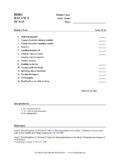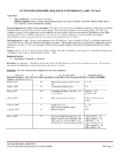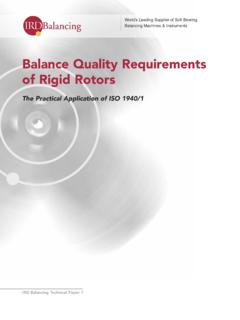Transcription of CHAPTER 4 - WEIGHT AND BALANCE AND …
1 CHAPTER 4 - WEIGHT AND BALANCE AND AIRPLANE PERFORMANCE atp incINTRODUCTIONA irplane performance is the capability of the airplane, if operated within its limitations, to accomplish maneuvers which serve a specific purpose. For example, most present-day airplanes are designed clean and sleek, which results in greater range, speed, payload, and increased efficiency. This type of airplane is preferred for cross-country flights. Airplanes used for short flights and carrying heavy loads, such as those used in certain agricultural operations, are designed differently, but still exhibit good performance for their purpose. Some of the factors which represent good performance are short takeoff and landing distance, increased climb capability, and greater speeds using less of its effect on performance, airplane WEIGHT and BALANCE information is included in this CHAPTER . Also included is an introduction to determining takeoff, cruise, and landing performance.
2 For information relating to WEIGHT and BALANCE , takeoff, cruise, and landing performance for a specific make and model of airplane, reference should be made to that Airplane s Flight Manual or Pilot s Operating CONTROLW eight is the force with which gravity attracts a body toward the center of the Earth. It is a product of the mass of a body and the acceleration acting on the body. WEIGHT is a major problem in airplane construction and operation, and demands respect from all force of gravity continually attempts to pull the airplane down toward Earth. The force of lift is the only force that counteracts WEIGHT and sustains the airplane in flight. However, the amount of lift produced by an airfoil is limited by the airfoil design, angle of attack, airspeed, and air density. Therefore, to assure that the lift generated is sufficient to counteract WEIGHT , loading the airplane beyond the manufacturer s recommended WEIGHT must be avoided.
3 If the WEIGHT is greater than the lift generated, altitude cannot be of WeightAny item aboard the airplane which increases the total WEIGHT significantly is undesirable as far as performance is concerned. Manufacturers attempt to make the airplane as light as possible without sacrificing strength or pilot of an airplane should always be aware of the consequences of overloading. An overloaded airplane may not be able to leave the ground, or if it does become airborne, it may exhibit unexpected and unusually poor flight characteristics. If an airplane is not properly loaded, the initial indication of poor performance usually takes place during WEIGHT reduces the flight performance of an airplane in almost every respect. The most important performance deficiencies of the overloaded airplane are: Higher takeoff speed. Longer takeoff run. Reduced rate and angle of climb. Lower maximum altitude.
4 Shorter range (more WEIGHT lifted = more work done = more fuel required). Reduced cruising speed. Reduced maneuverability. Higher stalling speed. Higher landing speed. Longer landing roll. Excessive WEIGHT on the pilot must be knowledgeable in the effect of WEIGHT on the performance of the particular airplane being flown. Preflight planning should include a check of performance charts to determine if the airplane s WEIGHT may contribute to hazardous flight operations. Excessive WEIGHT in itself reduces the safety margins available to the pilot, and becomes even more hazardous when other performance-reducing factors are combined with overweight. The pilot must also consider the consequences of an overweight airplane if an emergency condition arises. If an engine fails on takeoff or ice forms at low altitude, it is usually too late to reduce the airplane s WEIGHT to keep it in the ChangesThe WEIGHT of the airplane can be changed by altering the fuel load.
5 Gasoline has considerable WEIGHT 6 pounds per gallon 30 gallons may weigh more than one passenger. But it must be remembered that if WEIGHT is lowered by reducing fuel, the range of the airplane is decreased. During flight, fuel burn is normally the only WEIGHT change that takes place. As fuel is used, the airplane becomes lighter and performance is of fixed equipment have a major effect upon the WEIGHT of the airplane. An airplane can be overloaded by the installation of extra radios or instruments. Repairs or modifications usually affect the WEIGHT of the , Stability, and Center of GravityBalance refers to the location of the center of gravity (CG) of an airplane, and is important to airplane stability and safety in flight. The center of gravity is a point at which an airplane would BALANCE if it were suspended at that prime concern of airplane balancing is the fore and aft location of the CG along the longitudinal axis.
6 Location of the CG with reference to the lateral axis is also important. For each item of WEIGHT existing to the left of the fuselage centerline, there is an equal WEIGHT existing at a corresponding location on the right. This may be upset, however, by unbalanced lateral loading. The position of the lateral CG is not computed, but the pilot must be aware that adverse effects will certainly arise as a result of a laterally unbalanced condition. Lateral unbalance will occur if the fuel load is mismanaged by supplying the engine(s) unevenly from tanks on one side of the airplane. The pilot can compensate for the resulting wing-heavy condition by adjusting the aileron trim tab or by holding a constant aileron control pressure. However, this places the airplane controls in an out-of-streamline condition, increases drag, and results in decreased operating efficiency. Since lateral BALANCE is relatively easy to control and longitudinal BALANCE is more critical, further reference to BALANCE in this handbook will mean longitudinal location of the center of gravity.
7 [Figure 4-1]Figure 4-1. Lateral or longitudinal center of gravity is not necessarily a fixed point; its location depends on the distribution of WEIGHT in the airplane. As variable load items are shifted or expended, there is a resultant shift in CG location. The pilot should realize that if the CG of an airplane is displaced too far forward on the longitudinal axis, a nose-heavy condition will result. Conversely, if the CG is displaced too far aft on the longitudinal axis, a tail-heavy condition will result. It is possible that an unfavorable location of the CG could produce such an unstable condition that the pilot could not control the airplane. [Figure 4-1]In any event, flying an airplane which is out of BALANCE can produce increased pilot fatigue with obvious effects on the safety and efficiency of flight. The pilot s natural correction for longitudinal unbalance is a change of trim to remove the excessive control pressure.
8 Excessive trim, however, has the effect of not only reducing aerodynamic efficiency but also reducing primary control travel distance in the direction the trim is of Adverse BalanceAdverse BALANCE conditions affect airplane flight characteristics in much the same manner as those mentioned for an excess WEIGHT condition. In addition, there are two essential airplane characteristics which may be seriously affected by improper BALANCE ; these are stability and control. Loading in a nose-heavy condition causes problems in controlling and raising the nose, especially during takeoff and landing. Loading in a tail-heavy condition has a most serious effect upon longitudinal stability, and can reduce the airplane s capability to recover from stalls and spins. Another undesirable characteristic produced from tail-heavy loading is that it produces very light control forces. This makes it easy for the pilot to inadvertently overstress the for the location of the airplane s center of gravity are established by the manufacturer.
9 These are the fore and aft limits beyond which the CG should not be located for flight. These limits are published for each airplane in the Type Certification Data Sheet or Aircraft Specification. If, after loading, the CG is not within the allowable limits, it will be necessary to relocate some items within the airplane before flight is forward center of gravity limit is often established at a location which is determined by the landing characteristics of the airplane. It may be possible to maintain stable and safe cruising flight if the CG is located ahead of the prescribed forward limit; but during landing which is one of the most critical phases of flight, exceeding the forward CG limit may cause problems. Manufacturers purposely place the forward CG limit as far rearward as possible to aid pilots in avoiding damage to the airplane when restricted forward center of gravity limit is also specified to assure that sufficient elevator deflection is available at minimum airspeed.
10 When structural limitations or large stick forces do not limit the forward CG position, it is located at the position where full-up elevator is required to obtain a high angle of attack for aft center of gravity limit is the most rearward position at which the CG can be located for the most critical maneuver or operation. As the CG moves aft, a less stable condition occurs which decreases the ability of the airplane to right itself after maneuvering or after disturbances by some airplanes the CG limits, both fore and aft, may be specified to vary as gross WEIGHT changes. They may also be changed for certain operations such as acrobatic flight, retraction of the landing gear, or the installation of special loads and devices which change the flight actual location of the CG can be altered by many variable factors and is usually controlled by the pilot. Placement of baggage and cargo items determine the CG location.






